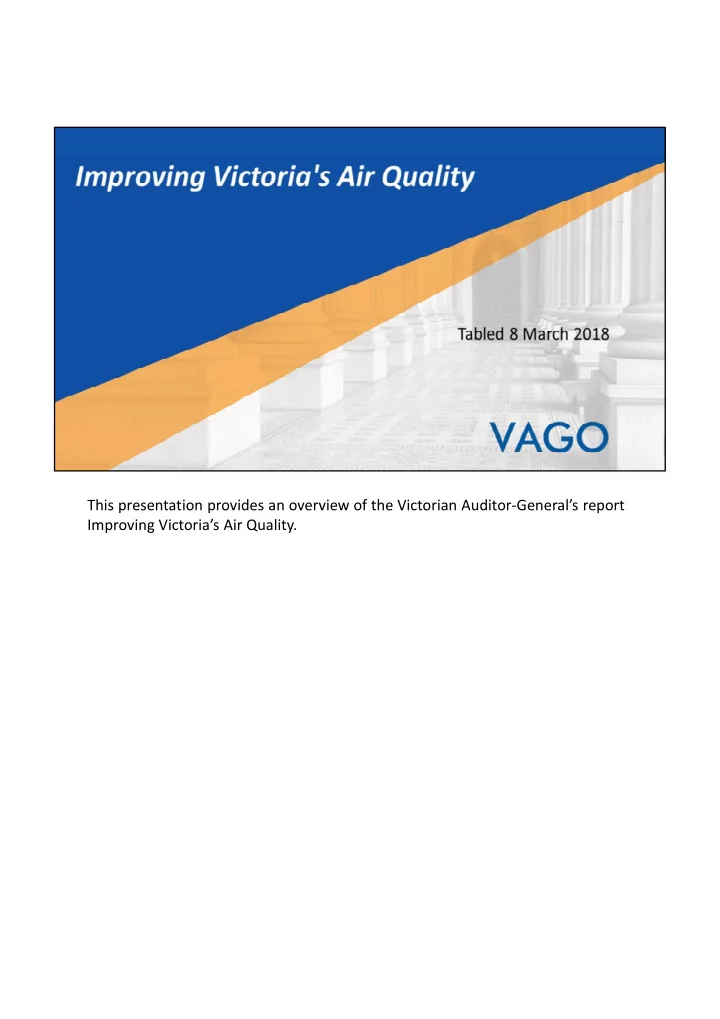

This presentation provides an overview of the Victorian Auditor ‐ General’s report Improving Victoria’s Air Quality.
Clean air is important for health and wellbeing. There is a strong correlation between poor air quality and negative health impacts. The air we breathe can contain ozone and particulate matter (PM) pollutants. These can arise from human sources, such as industrial operations, and from natural processes such as bush fires.
In Victoria, the Environment Protection Authority (EPA) is primarily responsible for monitoring, regulating and reporting on the state’s air quality. EPA is subject to a range of legislation that incorporate national standards on ambient air quality.
This audit examined whether Victoria’s air quality meets the standards for ozone and PM discharges. We looked at EPA’s monitoring, reporting and regulation of air quality.
The audit looked primarily at EPA’s activities relevant to air quality. We included the Department of Environment, Land, Water and Planning (DELWP) as the agency with portfolio responsibility over the environment. Brimbank City Council because of significant air pollution issues at the Brooklyn Industrial Precinct. And the City of Ballarat because of reported air pollution measures it undertook relative to woodfire heating.
EPA’s annual air quality monitoring reports state that ambient air quality is generally good and within national standards. This is true for the parts of the Port Phillip and Latrobe Valley regions that EPA monitors. EPA’s limited air monitoring coverage does not provide information on air quality for most of the state, including many parts of metropolitan Melbourne. The weaknesses we have identified means that EPA is unable to demonstrate that the data it collects and reports provides a representative measure of the air quality likely to be experienced by most Victorian communities.
We also found weaknesses in EPA’s reporting on air quality data. For example, we found errors in EPA’s assessments against PM standards, all of which overstated air quality and undermine confidence in EPA’s annual air quality monitoring reports. Basic sample checking showed inconsistencies between EPA’s raw data and what has been published. And, EPA’s data validation process is not being followed.
EPA reports annually on ambient air quality. There is no similar regular reporting for data collected from its campaign and emergency monitoring stations. It is important for Victorians to be able to access and understand the local air quality conditions that they may be exposed to on a daily basis, especially if they live, work and commute near direct sources of air pollution.
EPA’s regulation of sources of air pollution has begun to improve. It has achieved this through better embedding its risk ‐ based approach into its licensing requirements and developing programs to enhance its compliance efforts—for example, with its major industry assessments and periodic licence reviews.
The roles and responsibilities of agencies that contribute to air quality management remain unclear and not well understood. Consequently, attempts to address air quality issues have not always been well coordinated and implemented.
EPA needs to keep pace with information on air pollution sources. EPA last completed an air emissions inventory in 2006. This is inconsistent with EPA’s approach to use science to inform its activities. EPA’s primary reliance on the community and industrial operators to know about air discharges is not sound. EPA needs to consider how it could proactively obtain and validate information on air discharges from industrial operators.
We made four recommendations for EPA, and one further recommendation for EPA and the Department of Environment, Land, Water and Planning. EPA accepted all five recommendations and provided an action plan on how it will implement them. DELWP accepted the recommendation addressed to it, noting that it will also support EPA in its acquittal of the remaining recommendations.
For further information, please see the full report of this audit on our website, www.audit.vic.gov.au.
Recommend
More recommend